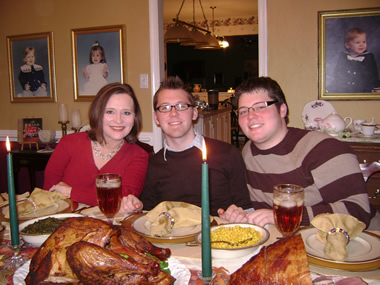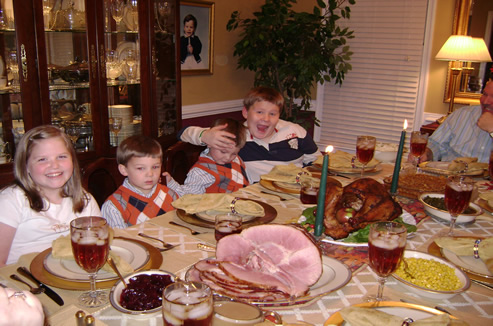| Share |  |
 | |||
Easy Mealtime Manners for Children
 Contrary to popular belief, it is possible to train your children to have nice manners; it just takes ample doses of consistency and patience. With six sons and a daughter at our dinner table, I know how challenging it can be to make sure the utensils don't become part of the after dinner entertainment. On more than one occasion, I've had butter knives turn into a drumming session, for the teens, and forks turn into sword fights for the preschool twins and toddler. Even my precious, ever-so-gracious,10-year-old daughter wants to make an aluminum microphone every time we have baked potatoes! Still, there is hope!
Contrary to popular belief, it is possible to train your children to have nice manners; it just takes ample doses of consistency and patience. With six sons and a daughter at our dinner table, I know how challenging it can be to make sure the utensils don't become part of the after dinner entertainment. On more than one occasion, I've had butter knives turn into a drumming session, for the teens, and forks turn into sword fights for the preschool twins and toddler. Even my precious, ever-so-gracious,10-year-old daughter wants to make an aluminum microphone every time we have baked potatoes! Still, there is hope!
Let manners be a natural, expected part of growing up. Have a routine mental checklist. No skill is mastered immediately. Don't strive for perfection right away. Don't expect any appreciation for your efforts. State the desired results and praise generously. Little by little, they will learn what is proper and acceptable; and you may be amazed to see the transformation of social refinement happen before your eyes. Just as math isn't mastered all in the first week of school, neither are proper manners and modes of behavior mastered at one meal. But lesson after lesson of practicing the fundamentals and becoming more comfortable with them, can produce amazing progress.
Here are a few guidelines that we review on a regular basis at our table. I've grouped and labeled them from my book for easy reference:
EASY MEALTIME MANNERS GUIDE:
- PACE: Never begin eating until everyone is served. This shows self-restraint and courtesy for everyone present. Never begin eating until the hostess has begun. This shows courtesy and ensures proper timing for the pace and completion of the meal. It would be rude to have the hostess just beginning, while someone else is just finishing. Likewise, don't begin eating dessert until everyone has completed their meal.
- POSTURE: Maintain good posture. Keep head up, back straight and shoulders level. Lean forward if necessary but not down. Only one hand should be in use while eating, except when cutting, buttering or passing. Hands should be calm and placed on lap when not in use. Elbows remain by your side, so as not to interfere with those next to you. Elbows and purses remain off the table during the meal.
- PASSING: Pass the food counter-clockwise (from left to right). This way we don't have a traffic jam. Use both hands. Also pass salt and pepper together. Serve moderate amounts, giving consideration to everyone who is to be served. Serve what is closest to you, and then pass. Don't pick through to find the biggest piece of chicken, or serve from the center of the dish. Keep food presentable to pass to the next person.
- PLEASANT: Consider others around you to ensure that your behavior and conversation are agreeable and appropriate. Keep the volume modest and engage in pleasant conversation. Maintain genuine interest and eye contact. Mealtime is a social gathering, not a private affair. Headphones, cell phones, books and other personal matters should be avoided during mealtime. There is much to be gleaned from conversations with others, that would be missed. Children learn much of their conversation skills around the table. Be sure your demeanor, countenance, and conversation are positive and pleasant.
- PRAYER: Never begin to eat without thanking the One true God, who provides for you all good things to enjoy for your nourishment and benefit. Chew slowly with your mouth closed and enjoy what has been prepared for you. This is not only proper and courteous, it also aides in good digestion Lastly, never leave the table without thanking the host who invited you and prepared it, and asking to be excused.

There are many other lessons in etiquette and protocol to learn, but if these basic guidelines are practiced, your children will grow up knowing the elements of proper manners and be a blessing to all those around them. And remember, learning isn't taught, it's caught! So set the example for your children on a regular basis and they will be much more likely to follow, and soon will have mastered mealtime manners.
(Author's note: Excerpts have been taken from her book, POISE & PERSONALITY: Etiquette, Manners and Social Graces, by Debbie Reynolds Harper; information is copyrighted and may not be reproduced without permission.)
Copyright © 2008-2015 Debbie Reynolds Harper
Post Your Comment...
|
|
||||||||||||


